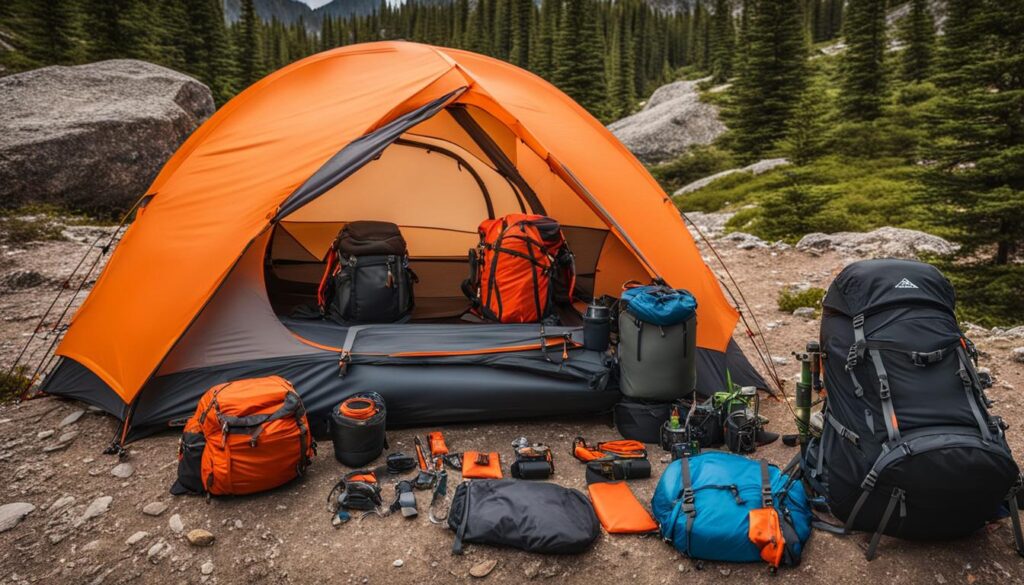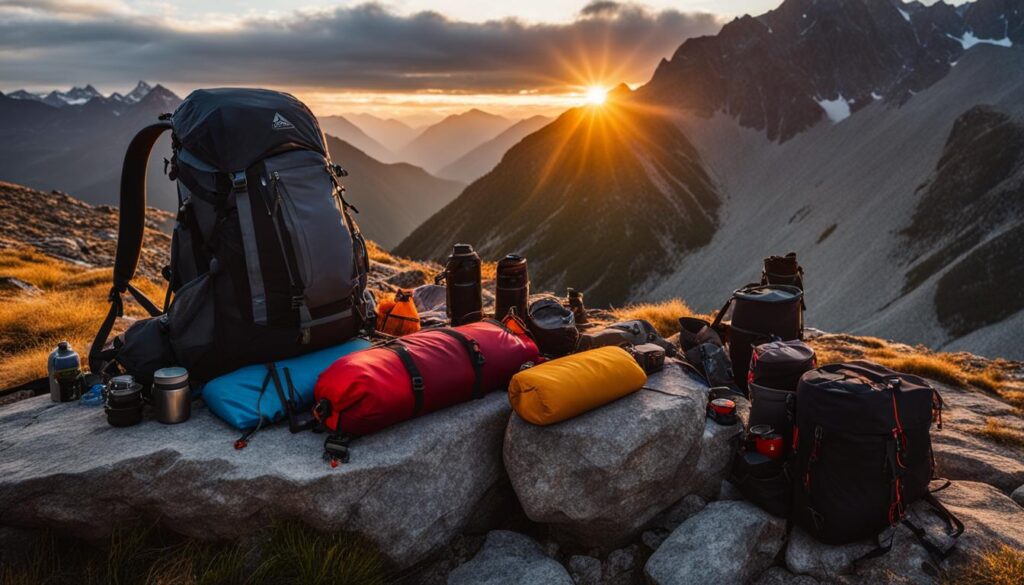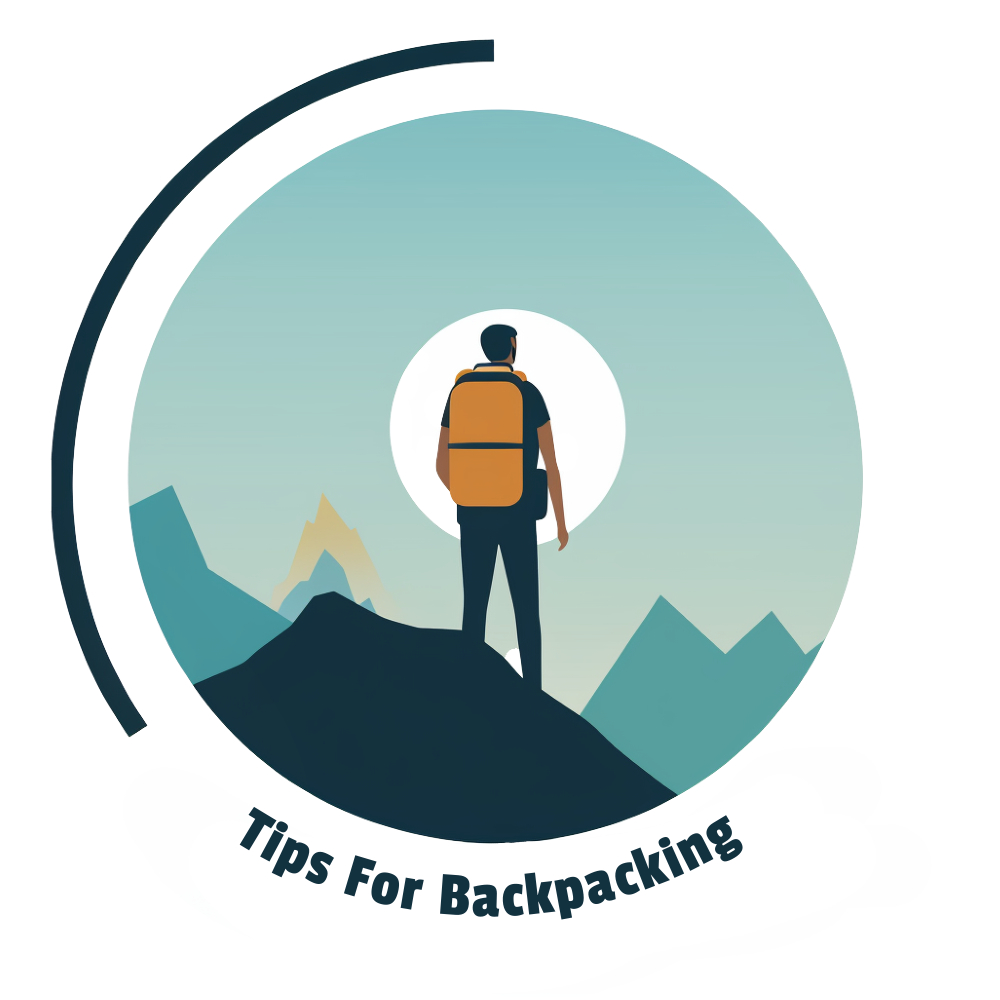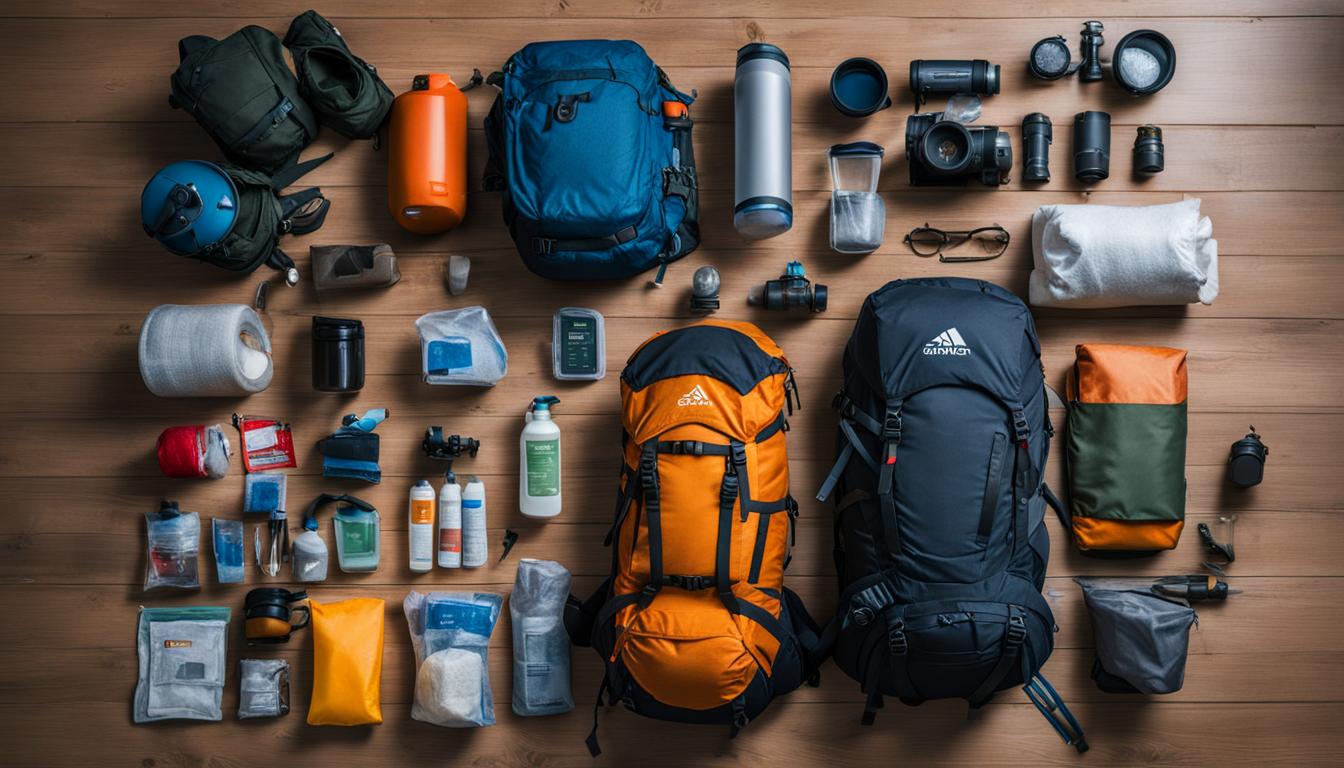A backpacking trip can be an amazing experience, but it’s crucial to be properly equipped. This comprehensive backpacking checklist covers the essentials for a three-season backpacking trip. It includes items such as a backpack, tent, sleeping bag and pad, water storage and filtration system, stove and cookware, food and snacks, clothing, footwear, personal hygiene items, electronics, and navigation tools. Following this checklist will ensure that beginners have all the necessary gear to embark on their first backpacking adventure.
Key Takeaways
- Make sure to have a properly sized backpack with a carrying capacity of 50-80 liters.
- Choose a beginner-friendly tent for livable space and protection.
- Pick a sleeping bag with the appropriate temperature rating and a sleeping pad for insulation and comfort.
- Don’t forget essential gear like a water bottle or reservoir, purification system, stove, fuel, pots, utensils, and food.
- Proper clothing, including hiking socks, pants or shorts, insulating layers, rain gear, and footwear, is crucial for comfort and protection.
- Pack personal hygiene items such as a trowel, toilet paper, hand sanitizer, sunscreen, and bug repellent.
- Bring electronics like a power bank, headlamp, and navigation tools like a compass or GPS device for safety and convenience.
Choosing the Right Backpack and Shelter

When preparing for a backpacking trip, one of the most important decisions is choosing the right backpack and shelter. These two items will greatly impact your comfort and safety during your adventure.
Backpack
When selecting a backpack, there are several factors to consider. First, you’ll need to determine the appropriate size. For a three-season backpacking trip, a backpack with a capacity of 50 to 80 liters is recommended. This size will allow you to carry all your essential gear without being too burdensome. Additionally, look for a backpack with a comfortable fit and adjustable straps to ensure proper weight distribution.
Next, consider the features that are important to you. Some backpacks have external pockets for easy access to frequently used items, while others have a hydration system built-in. Think about your specific needs and choose a backpack that aligns with them.
Shelter
When it comes to choosing a shelter, tents are the most popular option for beginner backpackers. They provide a good balance of livable space and protection from the elements. Look for a lightweight tent that is easy to set up and take down. Consider the number of people who will be sharing the tent and choose a size accordingly.
It’s also important to invest in a high-quality sleeping bag and sleeping pad. The sleeping bag should have a temperature rating suitable for the expected weather conditions. A sleeping pad will not only provide insulation from the ground but also add an extra layer of comfort for a restful night’s sleep.
| Item | Backpack | Tent |
|---|---|---|
| Size | 50-80 liters | Varies based on the number of occupants |
| Features | Adjustable straps, external pockets, hydration system compatibility | Lightweight, easy setup, weatherproof |
| Sleeping Bag | Not applicable | Temperature rating appropriate for expected weather conditions |
| Sleeping Pad | Not applicable | Provides insulation and comfort |
Essential Gear, Clothing, and Accessories

When preparing for a backpacking trip, it’s important to ensure you have the essential gear, clothing, and accessories to make your adventure safe and comfortable. Here are some key items to include on your packing list:
Water Storage and Filtration
- Water bottle or reservoir: Stay hydrated by carrying a reliable water container.
- Purification system: Keep your water clean and safe to drink by using a filtration or purification method.
Stove and Cookware
- Stove: Choose a lightweight and portable stove for cooking meals on the trail.
- Fuel: Ensure you have enough fuel to last throughout your trip.
- Pots and utensils: Pack lightweight and durable cookware and utensils for meal preparation.
Food and Snacks
- Plan your meals: Pack lightweight and nutritious options that are easy to prepare and won’t spoil.
- Snacks: Include energy-boosting snacks like trail mix, granola bars, and dried fruit.
Clothing
- Hiking socks: Invest in moisture-wicking and cushioned socks to keep your feet comfortable.
- Pants or shorts: Choose lightweight and quick-drying bottoms for hiking.
- Insulating layers: Pack layers that can be added or removed to regulate body temperature.
- Rain gear: Be prepared for wet weather with a waterproof jacket and pants.
Footwear
- Hiking boots or shoes: Find a pair that provides comfort, support, and traction.
- Sandals or camp shoes: Give your feet a break after a long day of hiking.
Personal Hygiene
- Trowel: As a responsible camper, bring a lightweight trowel for burying waste.
- Toilet paper: Carry a small amount of toilet paper and pack it out in a sealable bag.
- Hand sanitizer: Keep your hands clean and germ-free.
- Sunscreen and bug repellent: Protect your skin from sunburn and bug bites.
Electronics
- Power bank: Ensure your electronic devices stay charged during your trip.
- Headlamp: Don’t forget a reliable light source for nighttime activities.
Navigation
- Compass or GPS device: Always have a way to navigate and stay on track.
With the right gear, clothing, and accessories, you’ll be well-prepared for your backpacking adventure. Remember to pack efficiently and prioritize lightweight options to minimize your load. Happy trails!
| Item | Description |
|---|---|
| Water bottle or reservoir | A container for carrying water on the trail. |
| Purification system | A method to filter or purify water for safe consumption. |
| Stove | A portable device for cooking meals while backpacking. |
| Fuel | A source of fuel to power the backpacking stove. |
| Pots and utensils | Lightweight and durable cookware and utensils for meal preparation. |
| Plan your meals | Thoughtfully select and pack lightweight and nutritious meal options. |
| Snacks | Energy-boosting snacks to keep you fueled during your hike. |
| Hiking socks | Moisture-wicking and cushioned socks for maximum comfort. |
| Pants or shorts | Lightweight and quick-drying bottoms for hiking. |
| Insulating layers | Garments that can be layered for temperature regulation. |
| Rain gear | Waterproof jacket and pants to stay dry in wet weather. |
| Hiking boots or shoes | Footwear that provides comfort, support, and traction. |
| Sandals or camp shoes | Footwear to give your feet a break at camp. |
| Trowel | A lightweight tool for burying waste. |
| Toilet paper | A small amount of toilet paper for personal hygiene. |
| Hand sanitizer | A gel or liquid to clean and disinfect hands. |
| Sunscreen and bug repellent | Protection against sunburn and bug bites. |
| Power bank | A portable charger for electronic devices. |
| Headlamp | A hands-free light source for nighttime activities. |
| Compass or GPS device | A tool for navigation and staying on track. |
Can I Use Your Comprehensive Backpacking Checklist as a Template to Create My Own?
Yes, you can use our comprehensive backpacking checklist essentials as a template to create your own. Our checklist covers all the essentials for a successful backpacking trip, including clothing, camping gear, food, and safety items. Feel free to tailor it to your specific needs and preferences.
In Conclusion
Embarking on a backpacking adventure can be both exciting and challenging for beginners. But fear not, I’ve got you covered with this comprehensive backpacking checklist. By following this checklist and packing the necessary gear, you’ll be well-prepared for your journey.
As a beginner backpacker, it’s essential to have the right gear. Make sure you have a sturdy backpack that fits well and is the right size for your trip. A reliable tent will provide you with shelter and protection, while a comfortable sleeping bag and pad ensure a good night’s sleep.
Don’t forget to pack your water storage and filtration system, stove and cookware for cooking up delicious meals, and ample food and snacks to keep you energized on the trail. Additionally, proper clothing, footwear, and personal hygiene items are crucial for your comfort and well-being. And of course, don’t leave behind your essential electronics and navigation tools for safety and convenience.
So, whether you’re planning a weekend getaway or a longer backpacking trip, this checklist has got you covered. With the right gear and proper preparation, you’ll be well-equipped for your adventure. So pack your bags, check off the items on this backpacking checklist, and get ready to hit the trails. Happy backpacking!

